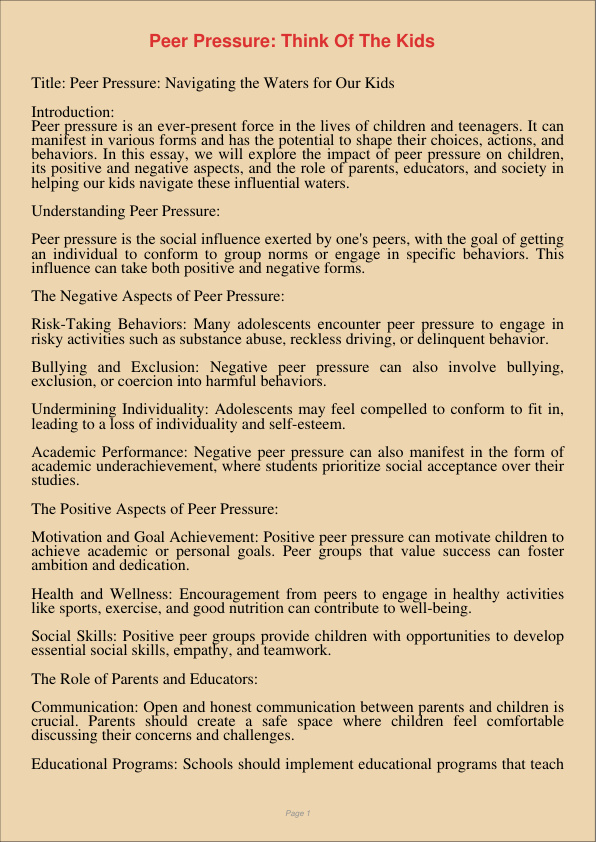Peer Pressure Think Of The Kids
Jan 6, 2024
peer pressure
think
Psychology
Human Resources
Title: Peer Pressure: Navigating the Waters for Our Kids
Introduction: Peer pressure is an ever-present force in the lives of children and teenagers. It can manifest in various forms and has the potential to shape their choices, actions, and behaviors. In this essay, we will explore the impact of peer pressure on children, its positive and negative aspects, and the role of parents, educators, and society in helping our kids navigate these influential waters.
Understanding Peer Pressure:
Peer pressure is the social influence exerted by one’s peers, with the goal of getting an individual to conform to group norms or engage in specific behaviors. This influence can take both positive and negative forms.
The Negative Aspects of Peer Pressure:
Risk-Taking Behaviors: Many adolescents encounter peer pressure to engage in risky activities such as substance abuse, reckless driving, or delinquent behavior.
Bullying and Exclusion: Negative peer pressure can also involve bullying, exclusion, or coercion into harmful behaviors.
Undermining Individuality: Adolescents may feel compelled to conform to fit in, leading to a loss of individuality and self-esteem.
Academic Performance: Negative peer pressure can also manifest in the form of academic underachievement, where students prioritize social acceptance over their studies.
The Positive Aspects of Peer Pressure:
Motivation and Goal Achievement: Positive peer pressure can motivate children to achieve academic or personal goals. Peer groups that value success can foster ambition and dedication.
Health and Wellness: Encouragement from peers to engage in healthy activities like sports, exercise, and good nutrition can contribute to well-being.
Social Skills: Positive peer groups provide children with opportunities to develop essential social skills, empathy, and teamwork.
The Role of Parents and Educators:
Communication: Open and honest communication between parents and children is crucial. Parents should create a safe space where children feel comfortable discussing their concerns and challenges.
Educational Programs: Schools should implement educational programs that teach students how to resist negative peer pressure and make informed decisions.
Teaching Critical Thinking: Parents and educators can help children develop critical thinking skills, allowing them to evaluate the consequences of their actions and the influence of their peers.
Positive Role Models: Positive role models in a child’s life can counteract negative peer pressure. These could be parents, teachers, or community leaders who embody the values and behaviors children should emulate.
Society’s Role:
Media and Advertising Regulation: Society must scrutinize and regulate media and advertising, as they can perpetuate negative peer pressure by promoting unhealthy behaviors or unrealistic ideals.
Mental Health Support: Access to mental health support should be readily available to address the emotional toll that negative peer pressure can inflict.
Community Involvement: Communities should encourage positive peer groups and after-school activities that foster constructive social interactions and teamwork.
Conclusion:
Peer pressure is a powerful force in the lives of our children, influencing their choices and behaviors. While it can be detrimental, it can also be a source of motivation and support. It is our collective responsibility, as parents, educators, and society, to equip children with the tools they need to navigate peer pressure effectively. By fostering open communication, teaching critical thinking, providing positive role models, and creating a supportive environment, we can help our kids make informed decisions and resist negative influences while embracing the positive aspects of peer pressure.
